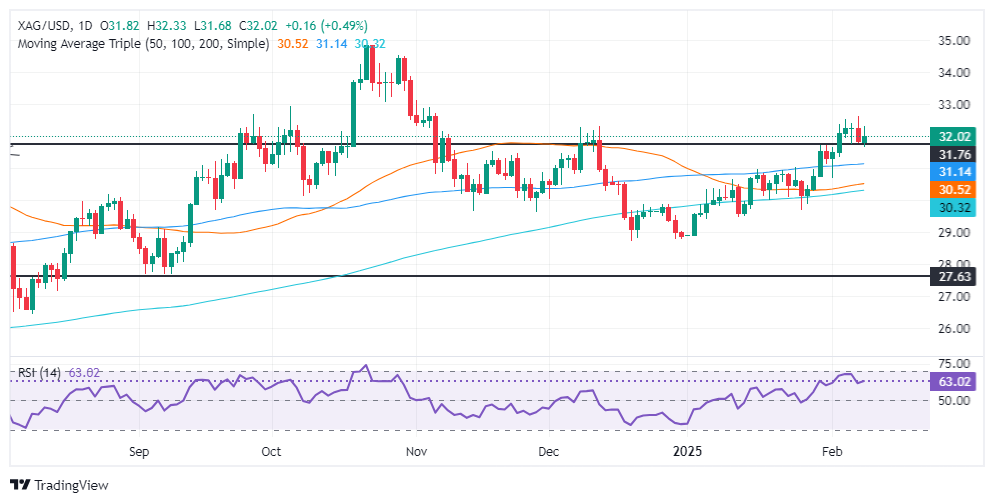Silver Price Forecast: XAG/USD rises and reclaims $32.00 on haven demand
- Silver's (XAG/USD) ascends as traders gravitate towards safe-haven assets.
- Technical outlook positive; Silver targets next resistance at $32.64 with potential to breach $33.00.
- Downside risks remain if Silver falls below $32.00, with potential support at the 100-day SMA of $31.11.
Silver prices advanced on safe-haven demand on Monday, rising 0.90% and reclaiming $32.00 per troy ounce at the time of writing.
Precious metals continued to perform positively on Monday after US President Donald Trump applied 25% tariffs on all aluminum and steel imports. This prompted traders to seek the safety of haven assets like Silver, Gold, and the US Dollar.
XAG/USD Price Forecast: Technical outlook
The grey metal remains consolidated despite trading with a bullish bias on Monday. Momentum favors further upside as the Relative Strength Index (RSI) remains above its 50 neutral lines, opening the door for additional gains.
If buyers clear the February 7 daily high of $32.64, it could pave the way for challenging the psychological $33.00 mark. The following key upside target would be the October 30 swing high at $34.51, followed by the October 23 peak at $34.86.
Conversely, if XAG/USD reaches a daily close below $32.00, it could pave the way for a retracement, as the non-yielding metal would face back-to-back bearish candles. If XAG/USD drops below $31.50 look get a test of the 100-day Simple Moving Average (SMA) at $31.11, ahead of $30.00.
XAG/USD Price Chart – Daily

Silver FAQs
Silver is a precious metal highly traded among investors. It has been historically used as a store of value and a medium of exchange. Although less popular than Gold, traders may turn to Silver to diversify their investment portfolio, for its intrinsic value or as a potential hedge during high-inflation periods. Investors can buy physical Silver, in coins or in bars, or trade it through vehicles such as Exchange Traded Funds, which track its price on international markets.
Silver prices can move due to a wide range of factors. Geopolitical instability or fears of a deep recession can make Silver price escalate due to its safe-haven status, although to a lesser extent than Gold's. As a yieldless asset, Silver tends to rise with lower interest rates. Its moves also depend on how the US Dollar (USD) behaves as the asset is priced in dollars (XAG/USD). A strong Dollar tends to keep the price of Silver at bay, whereas a weaker Dollar is likely to propel prices up. Other factors such as investment demand, mining supply – Silver is much more abundant than Gold – and recycling rates can also affect prices.
Silver is widely used in industry, particularly in sectors such as electronics or solar energy, as it has one of the highest electric conductivity of all metals – more than Copper and Gold. A surge in demand can increase prices, while a decline tends to lower them. Dynamics in the US, Chinese and Indian economies can also contribute to price swings: for the US and particularly China, their big industrial sectors use Silver in various processes; in India, consumers’ demand for the precious metal for jewellery also plays a key role in setting prices.
Silver prices tend to follow Gold's moves. When Gold prices rise, Silver typically follows suit, as their status as safe-haven assets is similar. The Gold/Silver ratio, which shows the number of ounces of Silver needed to equal the value of one ounce of Gold, may help to determine the relative valuation between both metals. Some investors may consider a high ratio as an indicator that Silver is undervalued, or Gold is overvalued. On the contrary, a low ratio might suggest that Gold is undervalued relative to Silver.

